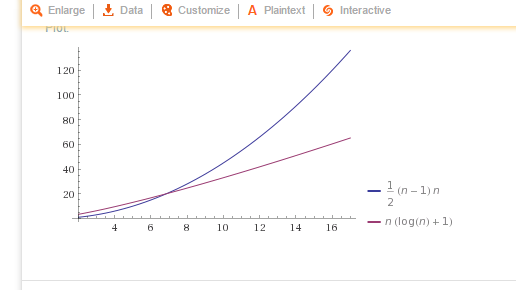To calculate total processing time, I wanted to graph the entire process, not just the sorting or just the one check. So I included the entire check process. So, when I graph
(n^2 - n )/2 vs (n log n)+n, n=2 to 17
on Wolframalpha, I get the following graph:

I see there is a point in which each function intersects. As this intersection of sets occurs in the positive quadrant of the graph, and (for our purposes) rather far into what our range of letters would be, I am inclined to say that we should provide both sets of algorithms for the code to use.
The intersection lies at about 7, so I would argue the following provides maximum efficiency:
if (word.length <=7) {(n^2-n)/2)};
else {(n log n) + n;
I am a high school math teacher, (though I don’t hold a math degree, rather a music degree.) so I understand the math part of it, mostly, but not all the coding/computer processing part of it, so I admit I may be missing something big here. Also, I understand that the difference in speed would be negligible for a program this size on modern machines. But of course we have to start thinking efficiency now, so later on our large programs work efficiently.
Really interested in what the instructors, @ben and @sampattuzzi, have to say about this.
EDIT:
Also, I wrote this before I saw the challenge to vote for the fastest. So… I guess this is my vote.
EDIT 2:
AAAAAAAND Of course I’m wrong. But still. I want to hear thoughts on this, to see if I’m “thinking like a programmer”